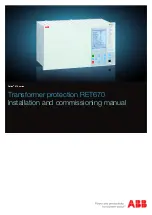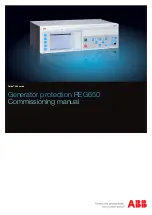
11
3.0 INSTALLATION
3.1 PLANNING:
Plan your Fall Protection System prior to installation of the Rope Grab. Account for all factors that may affect
your safety before, during, and after a fall. Consider all requirements, limitations, and specifications defined in Section 2
and Table 1.
3.2
INSTALLING THE RoPE GRAb:
The Rope Grab can be installed on approved Protecta vertical lifelines meeting the
requirements specified in Table 1. The vertical lifeline must be attached to an anchorage point meeting the requirements
of Section 2.1. Figure 10 illustrates installation of the Rope Grab. To install the Rope Grab:
1. Ensure the Rope Grab is in the “UP” position as indicated on the product label. The “UP” end of the Rope Grab must
be oriented up towards the anchorage when installed onto the lifeline (A).
2.
Push the opening lever (B) downward until it reaches the bottom of the groove. Press the opening lever inward until
the release button is completely depressed.
3. While the release button is being depressed, pull the rope grab and the locking cam apart until the unit is fully
opened.
4.
Install the lifeline by raising the locking cam to the “up” position and fitting the rope inside the lifeline channel (C).
Close the Rope Grab until the spring-loaded lock pin (D) snaps the unit shut. Verify that the spring-loaded lock pin
(D) and the opening lever (E) have returned to the locked position.
5. Test the operation of the Rope Grab by pulling down on the locking cam. The Rope Grab must lock onto the lifeline
and prevent any descent on the lifeline once the cam is engaged.
;
General Use Considerations:
Avoid working where lifeline may cross or tangle with that of another worker. Do
not allow the lanyard to pass under arms or between legs. Do not clamp, tie, or otherwise prevent the Rope Grab
lanyard connection handle from moving freely into the “locked” position.
4.0 USE
4.1
bEFoRE EACH USE:
Verify that your work area and Personal Fall Arrest System (PFAS) meet all criteria defined in
Section 2 and a formal Rescue Plan is in place. Inspect the Rope Grab per the ‘
User
’ inspection points defined on the
“
Inspection and Maintenance Log
” (Table 2). If inspection reveals an unsafe or defective condition, do not use the system.
Remove the system from service and destroy, or contact 3M regarding replacement or repair.
4.2
FALL ARREST CoNNECTIoNS:
The Rope Grab is used with a Full Body Harness and 3 ft. Energy Absorbing Lanyard.
Figure 11 illustrates connection of the Lanyard between the Harness and Rope Grab. Connect the Lanyard between the
Attachment Eye on the Rope Grab and the back Dorsal D-Ring on the Harness as instructed in the instructions included
with the Lanyard.
4.3
PoSITIoNING THE RoPE GRAb oN THE LIFELINE:
When using the Rope Grab on a vertical lifeline you should:
1.
Always work at a height that satisfies the fall clearance requirements for your application according to Figure 4. Using
the lanyard connected to the Rope Grab, pull up slightly on the Rope Grab to release it from its current position. Lift
the handle if necessary.
2.
Using the connected lanyard, raise or lower the Rope Grab to the desired new position. Tension the lifeline to assure
smooth operation of the Rope Grab along the lifeline. To tension the lifeline, either extend at least 50 ft. (15 m) of
lifeline below the Rope Grab, secure the end of the lifeline at working or ground level, or attach a six-to-ten-pound
counterweight at ground level. The method of tensioning should be determined by work site conditions.
3. After moving the Rope Grab to a new position, position it at or above shoulder height to reduce possible free fall. Lock
the Rope Grab at this position by pulling the lanyard connection handle to its full “DOWN” position. The handle must
be released before attempting to reposition the Rope Grab.
4.
Under certain conditions determined by a Qualified Person, such as working on a moving platform, it is allowable to
let the rope follow the worker as the platform is moved. The lanyard should be kept as short as possible and must not
exceed Lanyard length requirements as stated in Table 1.
5.
Always make sure the vertical lifeline has sufficient length for the application. Never set up the system in a manner
where the Rope Grab could become detached by sliding off the bottom of the vertical lifeline.
6. Never use a knot in the lifeline to limit the movement of the Rope Grab.
4.4
PARKING FEATURE:
1. To activate the parking feature, release the lever from the tab on the side of the Rope Grab and allow it to rotate
from vertical (Figure 12A) to horizontal (Figure 12B).
2.
The parking feature is now operational and will prevent the Rope Grab from traveling down the lifeline. This allows
the user to remain on the lifeline for a period without the threat of the Rope Grab moving down the lifeline when the
user is active. The Rope Grab operates in manual mode while the park feature is engaged.
3. To deactivate the parking feature, return the auto-locking lever to upright, allowing the hole in the lever to catch on
the tab on the side of the Rope Grab vertical position. Unlock from the lifeline by lifting up on the locking cam.
5.0 INSPECTION
5.1
INSPECTIoN FREQUENCY
1
:
The vertical lifeline system, including the rope grab, drop line, and lanyard, shall be inspected
by the user before each use and, additionally, by a Competent Person
2
other than the user at intervals of no longer than
one year. Inspection procedures are described in the
“Inspection and Maintenance Log”
. Results of each Competent Person
inspection should be recorded on copies of the
“Inspection and Maintenance Log”
.
Summary of Contents for PROTECTA Cobra
Page 2: ......
Page 4: ...4 6 7 A B C 8 9 A B C D E F G 1 2 A D E B C F A B C E ...
Page 5: ...5 10 11 12 A B D A B C E ...
Page 14: ......
Page 15: ......


































